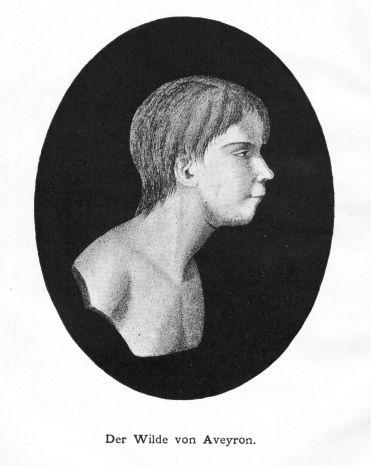I just finished reading The Wild Boy of Aveyron by Harlan Lane. I discovered this book after a recent post by Teresa on Shelf Love. Teresa and Jenny, who blog together on Shelf Love, have prompted me to add several books to my ‘to-read’ list recently. This book was a great addition.
The book starts with detailing the life of Victor of Aveyron who was a young boy who was found wandering alone in the woods of France at the end of the 18th century. There has been much speculation as to his origin, but he was most likely a developmentally disabled child that was abandoned in the woods who was then able to survive on his own. He was found naked and living on roots and plants that he was able to scavenge on his own.
This story is mainly used as a way to introduce what I see to be the main subject of the book, which is the development of sensory education. Victor is sent to the National Institute of the Deaf in Paris to be examined by Roch-Ambroise Cucurron Sicard. Eventually, Victor came under the care of Jean Marc Gaspard Itard who worked with him for five years. The book covers many of the different experiments and activities that Itard used with Victor with varying degrees of success. At the end of the five years, Victor went to live with Itard’s housekeeper until his death 20 years later.
Itard is known for his work with deaf-mutes and also described the first case of Torrette’s syndrome in 1825. One of the students of Itard was Edouard Seguin who worked with children with cognitive impairments both in France and the United States. The book details some of the work that Seguin did with speech disabilities and mental handicaps.
Another interesting section of the book deals with the development of sign language both in France and the United States and the question is asked as to why Itard did not attempt to teach Victor sign language.
Lane also explores the connection between the work of Itard and Seguin with Maria Montessori. The writings of Itard and Sequin and Montessori’s own research with children with developmental disabilities helped build the foundation of the method that bears her name today. Although not mentioned in this book, Froebel and Pestalozzi also had a large influence on Montessori’s work. (Pestalozzi is one of my favorite early educators.)
While reading this book, I had to remind myself that it was written in the 1970’s. Since that time there has been major changes in education for both the deaf and mentally disabled. Also, there has been a lot of research done on development disorders. I would be interested in knowing how the author would classify Victor with the current DSM-IV codes. My belief is that he would be classified as having a Pervasive Development Disorder (i.e. somewhere on the autism spectrum). Lane does discuss the possibility as to whether Victor was autistic in the book, but the discussion is based on the much narrower definition of autism from that time.
I am sure that the Wild Boy of Aveyron will always remain an enigma, but his story continues to influence research into developmental disorders and sensory education.
Steven



I’m so glad that you enjoyed this. There was a lot of really interesting material in it.
We have friends with differently-abled children. After reading your review, I think it would be a great challenge to deploy a child in such a way today. And I know that our friends consider their children blessings.
Thank you for visiting my Mindful 4 (Jan) post.
Best to you.
How sinister were his guardians to abandon a child in the forest. Amazing that he survived. It’s like a ‘true-life’ Jungle Book.
Fascinating, thanks!!